You might already know that link building is huge for SEO.
But how do you actually get other sites to link to your amazing content?
The answer: link building outreach.
Link building outreach is all about contacting the right people with the right message at the right time.
And in this guide, you’ll learn exactly how to do that.
What Is Link Building Outreach?
Link building outreach is the process of contacting other sites or influencers and asking them to create links that point back to your own website.
The purpose is to increase your site’s visibility and credibility—which can help improve its rankings on search engines.
But getting links isn’t easy. You can’t just spam people with random requests. You need to offer them something valuable in return.
That’s where link building outreach comes in.
Link building outreach involves finding relevant and authoritative websites, crafting personalized and persuasive messages, and building relationships with other webmasters.
The goal is to convince them that your content is worth linking to. And that linking to it will benefit them and their audience.
Why Is Link Building Outreach Important?
Link building outreach is one of the most effective ways to boost your website’s visibility in search engine results.
Why?
Because link building outreach helps you get high-quality backlinks from other relevant and authoritative sites in your niche.
And backlinks are like votes of confidence for your website. They signal to search engines that your content is valuable, trustworthy, and relevant to your target audience.
The more high-quality backlinks you have, the higher your website will likely rank for your target keywords.
And the higher you rank, the more organic traffic you typically get from search engines.
That’s why link building outreach is important. It’s not just about getting links. It’s about getting links that matter.
How Link Building Outreach Works
So, you know that link building outreach is all about getting other websites to link to your content.
But how do you actually do it?
It boils down to three main steps:
1. Create High-Quality Content People Will Be Interested in
The first step is to create content that’s valuable, relevant, and engaging for your target audience.
This could be a blog post, a video, an infographic, a case study, a guide, or anything else that provides useful information. Or solves a problem.
The key is to make sure your content is:
- Original: Don’t copy or rehash what others have already said. Add your own insights, data, and perspective.
- Comprehensive: Cover the topic in depth and don’t leave any gaps or questions unanswered
- Actionable: Give your readers clear and specific steps they can take to apply what they’ve learned
- Visual: Use images, screenshots, charts, graphs, and other visual elements to make your content more appealing and easier to understand
2. Identify Websites, Journalists, or Influencers Who May Want Your Content
The next step is to find potential link partners who are interested in your topic and have a similar or complementary audience to yours.
There are many ways to do this, but here are some of the most common:
- Use Google: Search for keywords related to your content and see which websites rank. You can also use advanced search operators like “inurl:,” “intitle:,” and “intext:” to narrow down your results.
- Use social media: Look for popular posts, hashtags, and accounts that are related to your content on platforms like Twitter, Facebook, LinkedIn, and Instagram. See who’s sharing, commenting, and engaging with them.
- Use tools: Use tools like our Link Building Tool to find potential prospects you can reach out to. Or Backlink Analytics to see who’s linking to your competitors and which types of content tend to earn the most backlinks.
3. Pitch Your Content in a Personalized Way
The final step is to contact your prospects and ask them to link to your content.
But don’t just send a generic email that says “Hey, I have this awesome content. Please link to it.”
That won’t work.
You need to:
- Personalize: Address your prospect by name and mention something specific about their website, content, or profile that shows you did your research and aren’t spamming them.
- Explain: Express why your content is relevant, valuable, and useful for them and their audience. Highlight your content’s main benefits and features. And how it can help them achieve their goals or solve their problems.
- Ask: Ask for a link in a polite and friendly way. Don’t be pushy or demanding. Make it easy for them to say yes by providing a clear call to action (CTA) and a link to your content.
Here’s an example of a good outreach email:
Subject line: Loved your post on SEO trends for 2024
Hey David,
I’m Carlos, a content marketer at Semrush.
I just read your post on SEO trends for 2024 and really enjoyed it. You did a great job of covering the latest developments and best practices in the industry.
I especially liked your point about voice search and how it’s changing the way people behave online.
In fact, I recently published a guide on how to optimize your site for voice search. And I think it’d be a great addition to your post.
It covers concepts like keyword research, content creation, schema markup, and technical SEO that can help you rank higher and get more traffic. All from voice search.
You can check it out here: [link to your content]
I think it could provide a lot of value to your readers and help them get better results from voice search.
Let me know what you think.
Cheers,
Carlos
P.S. I’m also a big fan of your podcast. Keep up the good work!
And that’s it.
Follow these steps, and you’ll be on your way to getting high-quality backlinks from authoritative and relevant sources.
Effective Link Building Methods
Now that you know what link outreach is and why it matters, let’s dive into some of the most effective tactics you can use to do it.
The Skyscraper Technique
The skyscraper technique is a tactic where you find the best piece of content on your topic, create something better, reach out to people who linked to the original, and ask for them to link to you instead.
This technique works because you’re not reinventing the wheel. You’re building on what’s already working.
And you’re offering something valuable to the people who care about your topic.
Here’s how to execute the skyscraper technique in three simple steps:
1. Find a Popular Piece of Content on Your Topic
The first step is to find content that’s already attracted a lot of links from other sites.
This is your base for creating something better.
One way to do this is to enter a competitor’s domain into Backlink Analytics and head to the “Indexed Pages” tab.
You’ll see a list of your competitor’s pages sorted by the number of referring domains (i.e., websites linking to those pages).
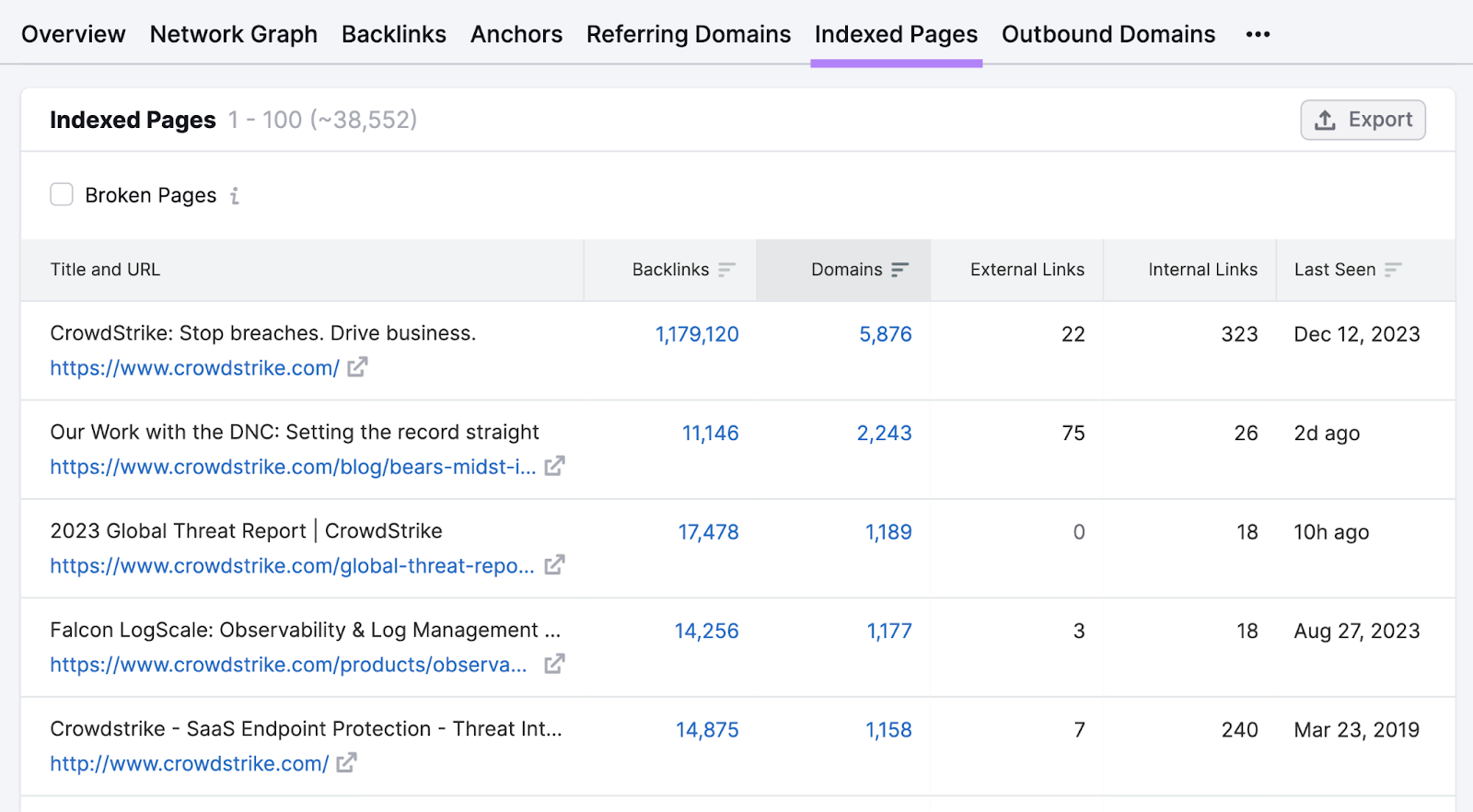
Use the external link icon to view the pages in a new tab. Do this for at least the top five.
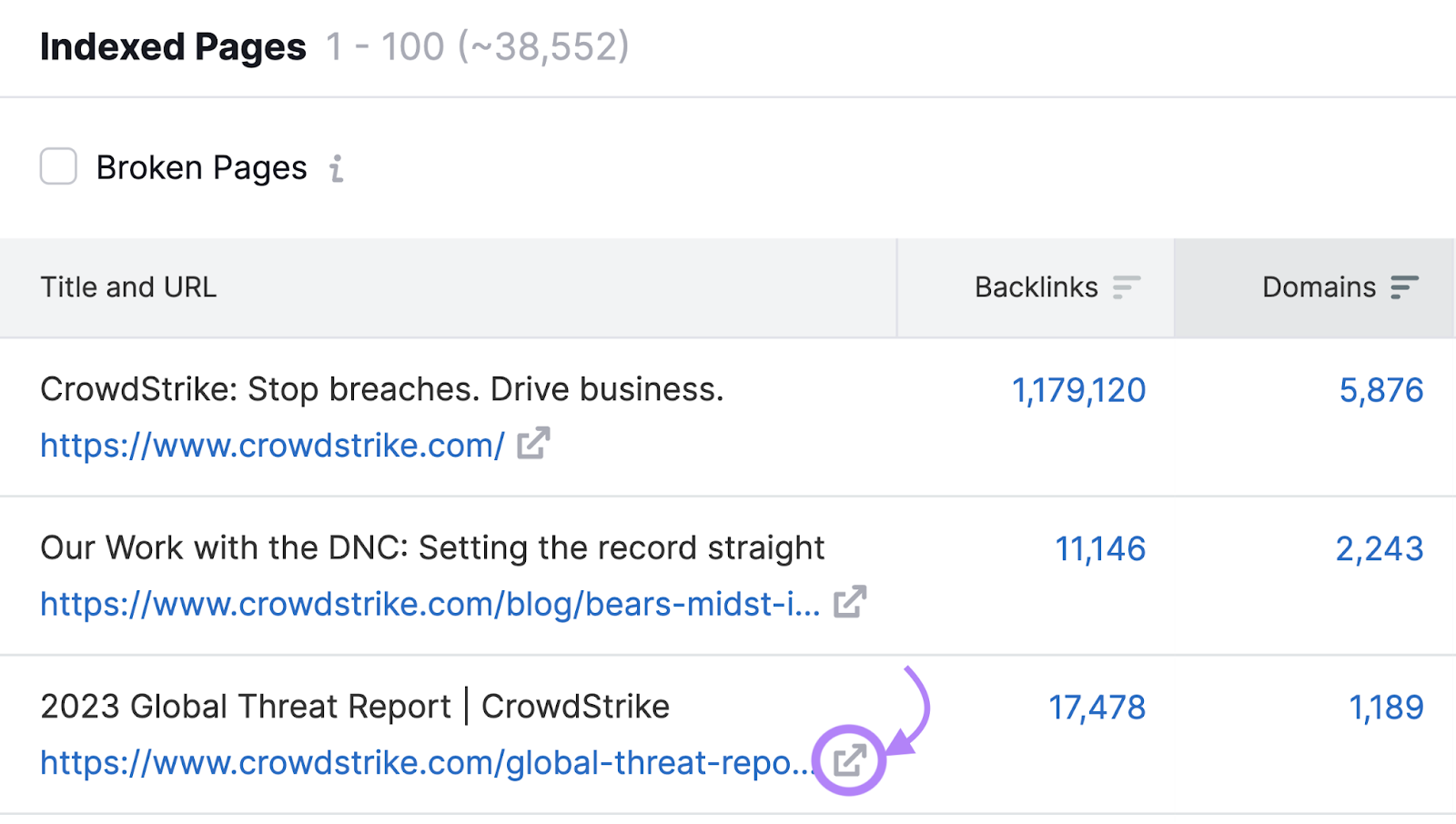
Analyze them in more detail. And look at the format, style, and length.
For example:
- Do they use lots of visual assets?
- Are the formats more short-form or long-form?
- Are they how-to guides, listicles, templates, or something different?
Then, click the number in the “Backlinks” column to see all the pages linking to that resource.
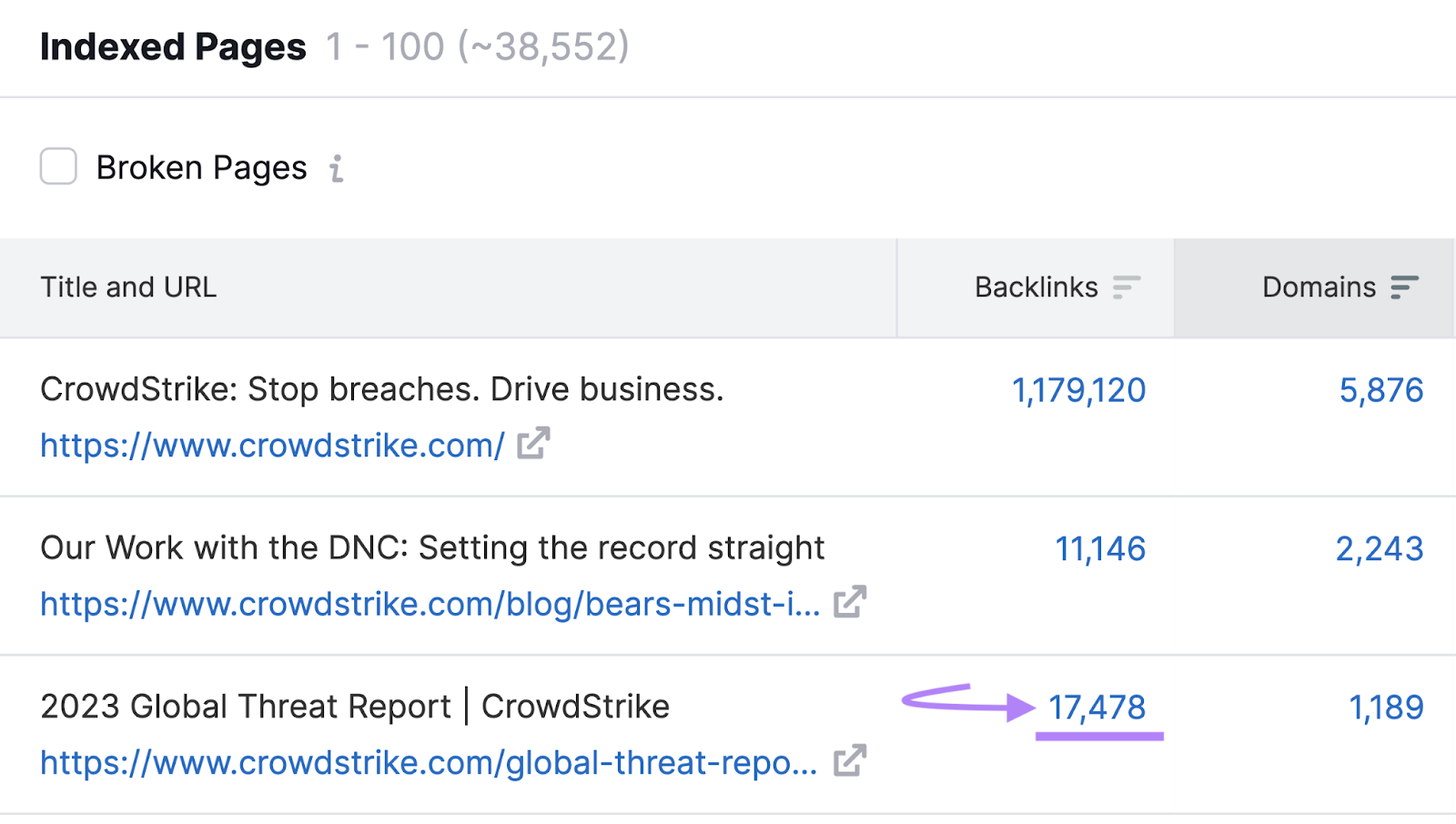
Those are the prospects you’ll reach out to.
Do this for several competitors. To compile a list of potential topics you can create pieces around.
Then, choose one that matches your niche and audience. This is what you’re going to create content for to improve upon what your competitor created and outrank them.
2. Create a Better Version of That Content
The second step is to create a better version of the content you found in step one.
This means providing more value, more depth, more insights, more examples, more visuals, and more up-to-**** information than the original content.
But what does “better” mean?
It depends on the content type and format. But here are some general ways to make your content better:
- Make it longer and more comprehensive: Cover more angles and details. Provide more examples, case studies, and data. And include more images, videos, and infographics.
- Make it more current and relevant: Update any outdated information, statistics, or references. Add new trends, insights, and developments. And address any recent changes or challenges in the industry or niche.
- Make it more engaging and user-friendly: Write in a clear, concise, and conversational tone. Use headings, subheadings, bullet points, and lists to break up the text. Use transitions, hooks, and storytelling to keep the reader interested. And optimize your content for SEO and readability.
- Make it more actionable and practical: Provide clear and specific steps, tips, and advice. Include tools, resources, and templates that the reader can use. And show the results and benefits of reading your content.
The goal is to create a piece of content that’s so good, it makes the original piece look outdated, incomplete, or boring.
Further reading: What Is Quality Content & How to Create It
3. Promote Your Content to the Right People
The third and final step is to promote your content to the sites that linked to the original piece.
These are your ideal link prospects. Because they’ve shown interest in your topic and are willing to link to similar content.
Here’s how you can reach those prospects:
Add the URL of the original resource you chose to improve to Backlink Analytics and head to the “Backlinks” tab.
You’ll see all the pages that link to the resource.
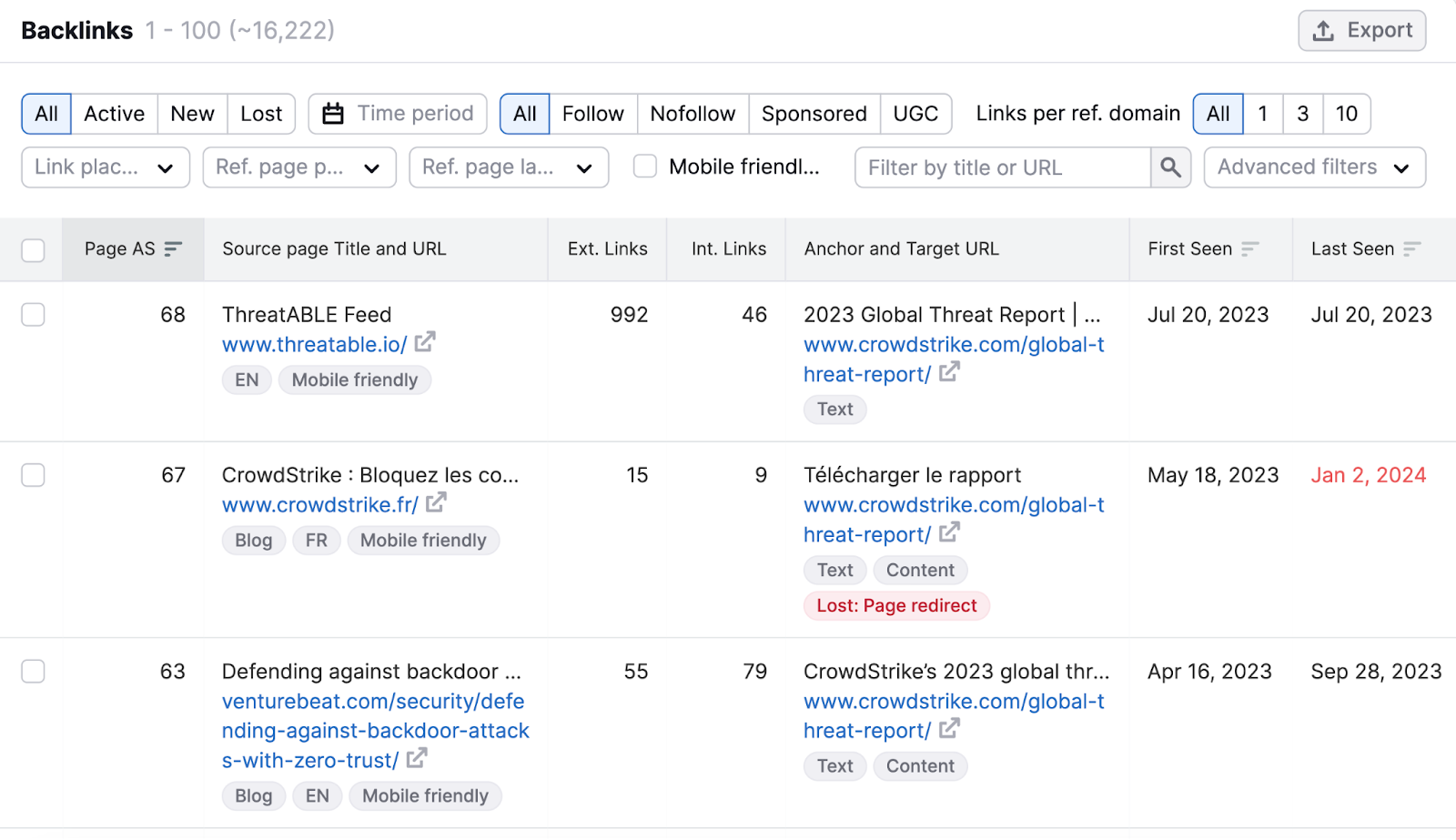
Then, open each page to see if you can find the author and their contact information.

If the page doesn’t list an author, try reaching out to someone on the editorial/content team.
And know that there are tons of ways to find email addresses.
For example, you can use a prospecting tool like FindThatLead Domain Searcher to search a website, see who works there, and gather those employees’ email addresses.
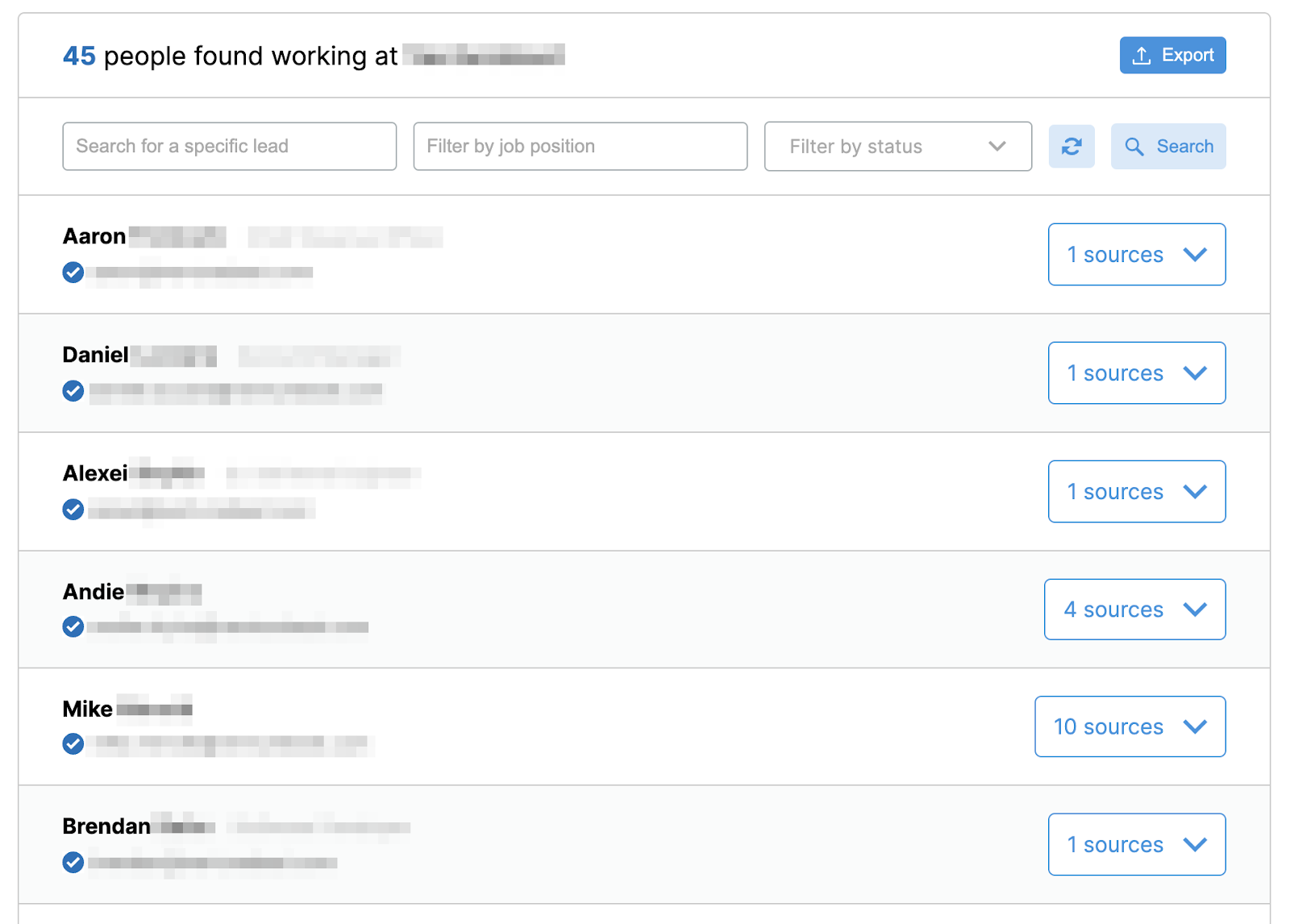
Once you have the contact information for each page’s author, craft a personalized and compelling email—don’t use generic or spammy templates.
Write a short and friendly email that addresses the recipient by name, compliments their work, introduces your content, explains why your piece is better than the original piece they linked to, and asks for a link.
Further reading: Email Outreach: How to Write Outreach Emails that Convert
The Moving Man Technique
The moving man technique involves contacting sites linking to outdated content and requesting they link to you.
The key is finding outdated links on pages within your niche that have a quality backlink profile.
1. Locate Outdated Content
First, find resources or sites that are outdated or inactive.
Links can often become obsolete due to:
- Rebranding
- New URLs
- Defunct services
- Defunct products
- Lack of maintenance
To find these now outdated resources, you can use the following advanced search strings or search modifiers on Google:
- “service not available” + [industry keyword/article topic]
- “we have moved” + [industry keyword/article topic]
- “page no longer exists” + [industry keyword/article topic]
- “this website is no longer updated” + [industry keyword/article topic]
- “this page is no longer updated” + [industry keyword/article topic]
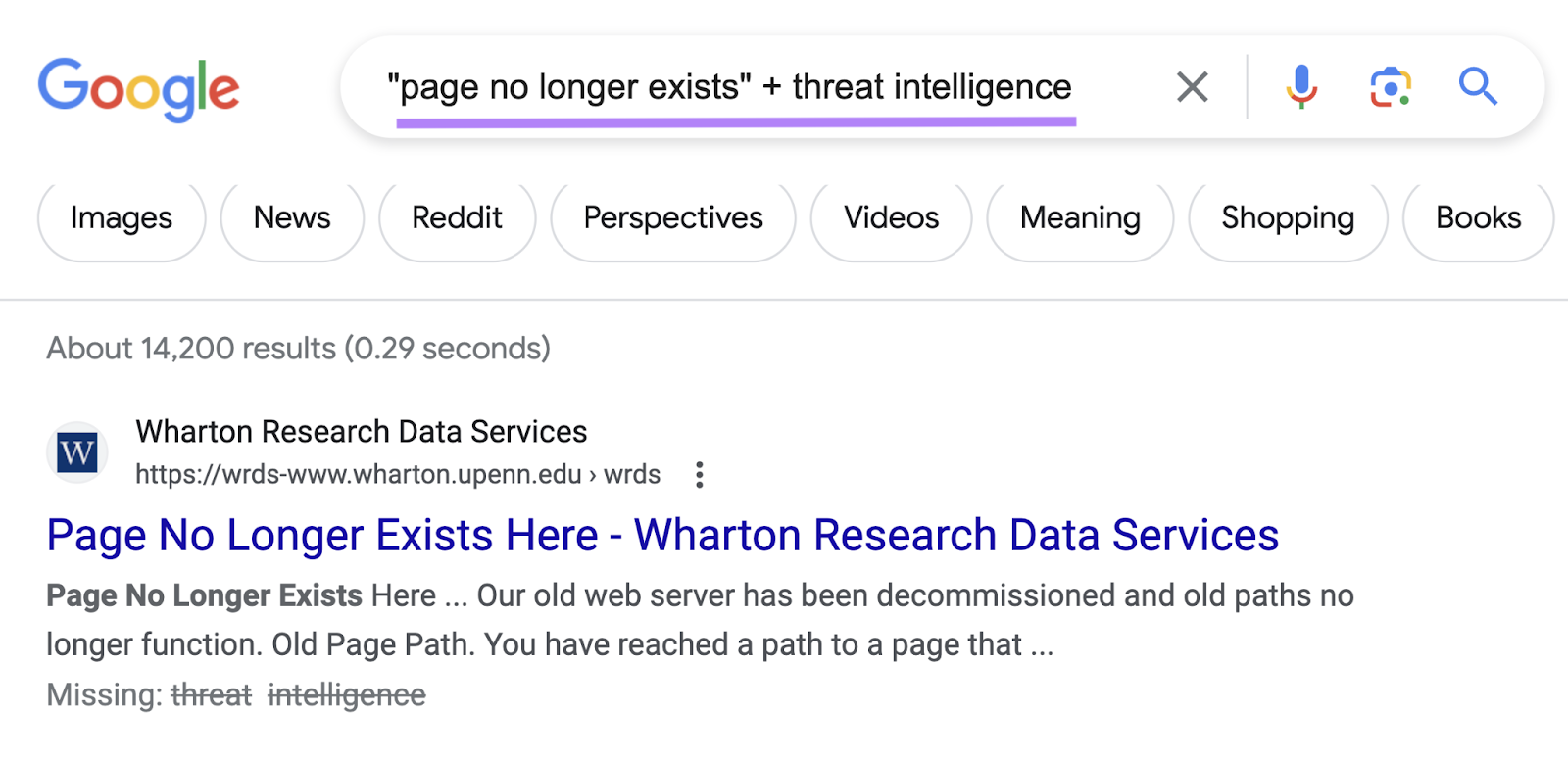
Further reading: How to Use Google Advanced Search Operators to Improve Your SEO
2. Find Backlinks to Outdated Content
Once you have a list of outdated resources, use Backlink Analytics to find the pages linking to each of them.
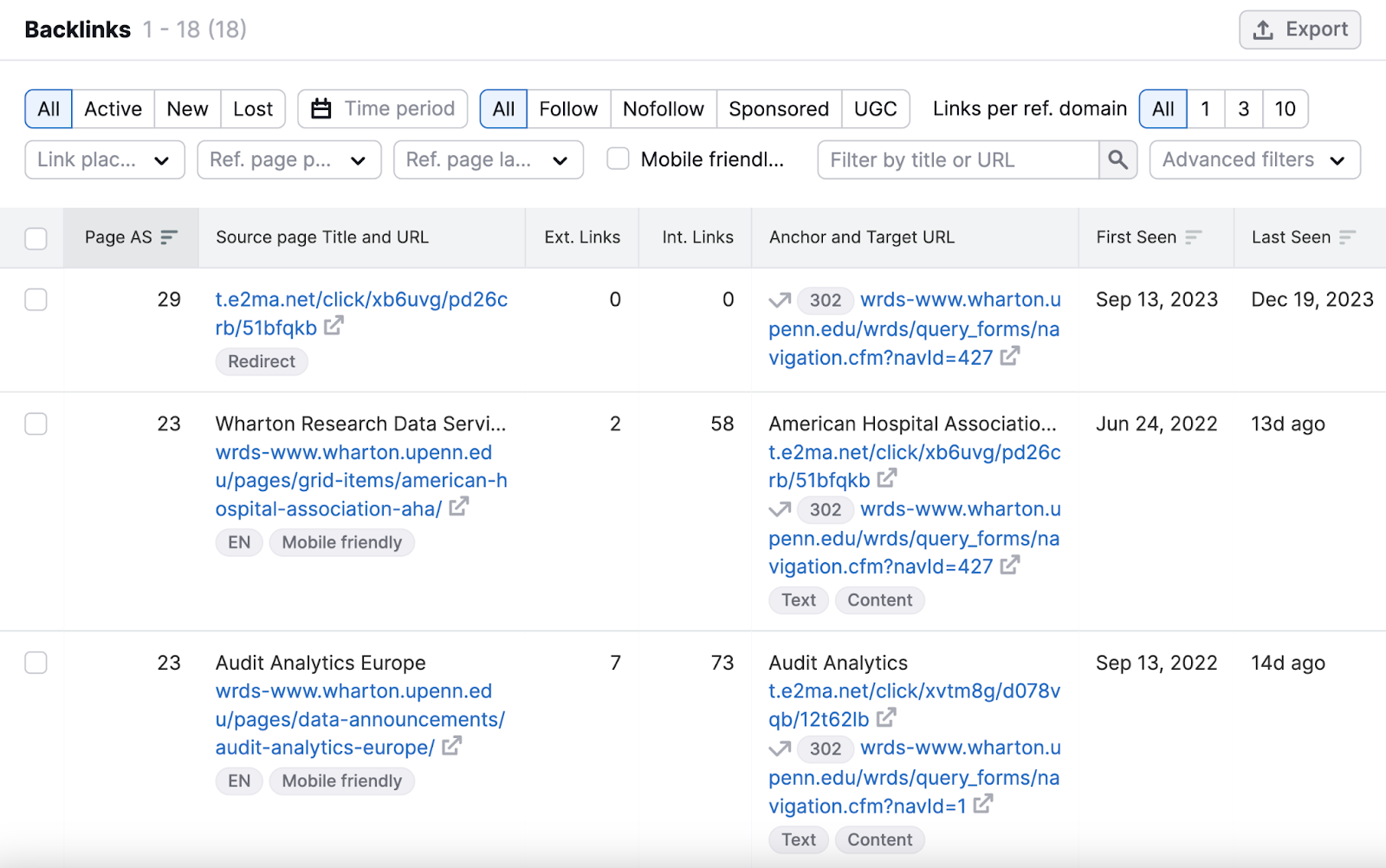
3. Create or Update Content
Create a new page or update an existing page with high-quality, helpful content.
You want your content to be as unique and engaging as possible.
For every link building technique, the resource you pitch needs to be excellent. Because you want people to want to link to it.
4. Promote Your Content
Your last step is to find the authors or site owners and promote your new, updated content.
Let them know about their outdated link. And kindly pitch yours.
Guest Posting
Guest posting involves writing and publishing articles on other websites or blogs in exchange for a backlink to your own site.
Here’s how you can start.
1. Find Authoritative Blogs in Your Industry
First, find high-performing or authoritative blogs in your industry that accept guest posts.
Otherwise, you may be wasting your SEO outreach efforts.
To find these blogs, try using different search strings. Like these:
- “Guest author” + [industry keyword]
- “Guest post” + [industry keyword]
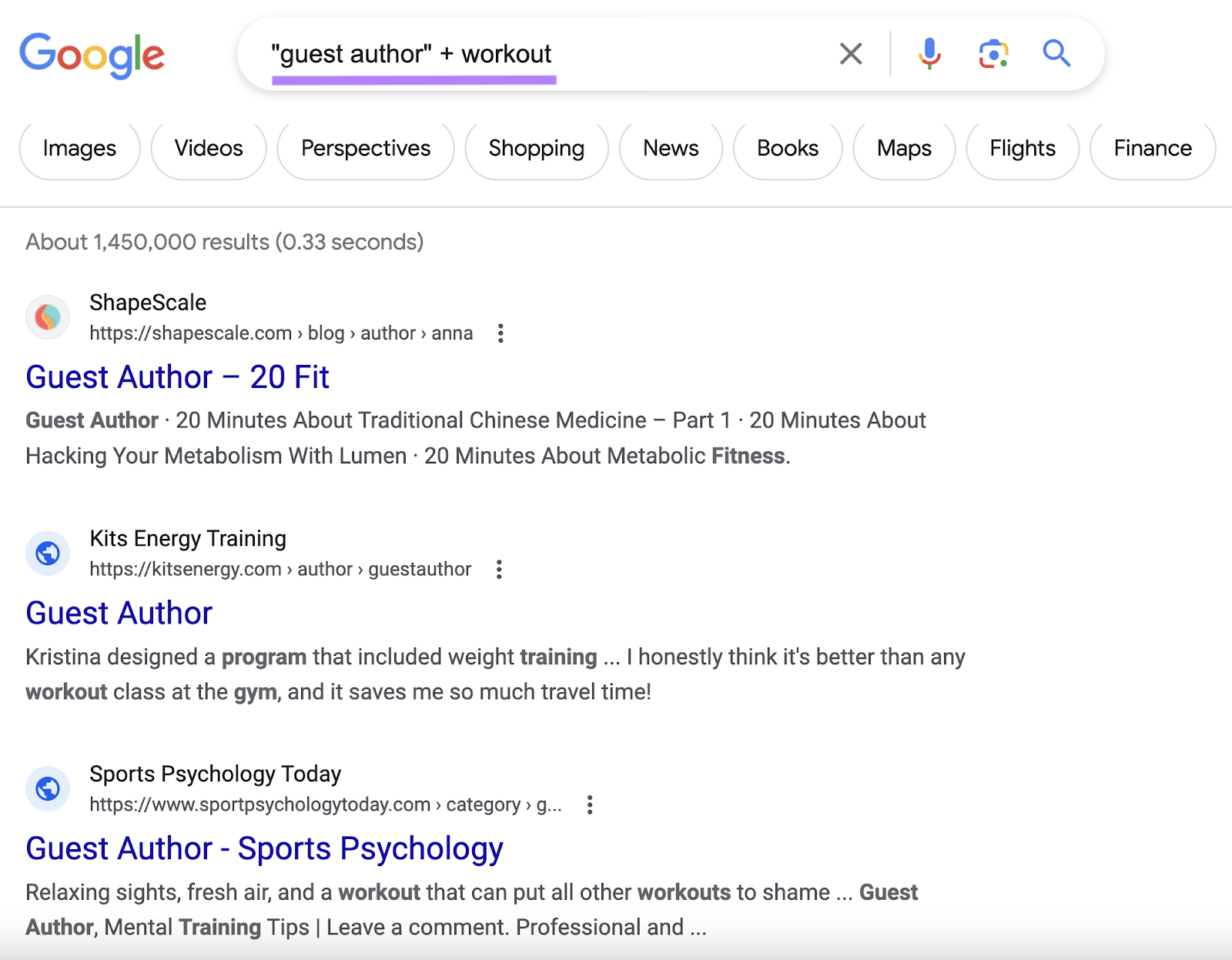
Then, use Domain Overview to analyze each site. And pay special attention to the overall traffic, Authority Score (a metric that estimates how reputable a site is), and backlink profile.

2. Request a Guest Post
Next, you’ll need to contact these blogs in an approachable manner. Not all are equally as receptive to guest posting.
It might help to already have the article created. So they can review it while considering your pitch.
3. Deliver Content with Links
The final step involves writing the guest post if you haven’t yet.
Your guest content should be just as engaging, helpful, and accurate as the content you create for your own website. If not more so.
Then, ensure that a backlink to your site with relevant anchor text is included in the article. This step is different for every prospect you contact, so make sure you follow their guidelines.
Further reading: How to Guest Post for SEO
Journalism Sourcing Platforms
Journalism sourcing platforms are online services that connect journalists (or other content creators) with experts like you.
They can be great ways to get high-quality backlinks from authoritative websites and publications. Because those publications often link back to your website when they mention you as a source.
To leverage this method, follow these steps:
1. Register with an Online Journalism Sourcing Platform
First, sign up for one or more platforms that match your niche and expertise. Some of the most popular ones are:
- Connectively: The largest and most well-known platform, Help a Reporter Out (HARO), has moved to a new app: Connectively. You can choose from dozens of categories ranging from business and finance to health and wellness.
- Qwoted: A newer platform that focuses on financial and business topics. You can create a profile, showcase your expertise, and pitch directly to journalists.
- Cision: The company offers a comprehensive PR and media database that lets you find and contact journalists, bloggers, and influencers. You can also use advanced filtering to find just the right media contacts.
- Muck Rack: Another PR and media database that helps you find and pitch journalists, track your outreach, and measure your results. You can also easily manage follow-up messages.
2. Set Up Customized Alerts
Once you register with a journalism sourcing platform, set up alerts to get notified of relevant queries from journalists.
Depending on the platform, you can customize your alerts by topic, keyword, industry, or publication.
For example, on Qwoted, you can select topics you’re able to speak to as an expert when setting up your profile. Which will send relevant media opportunities to you.
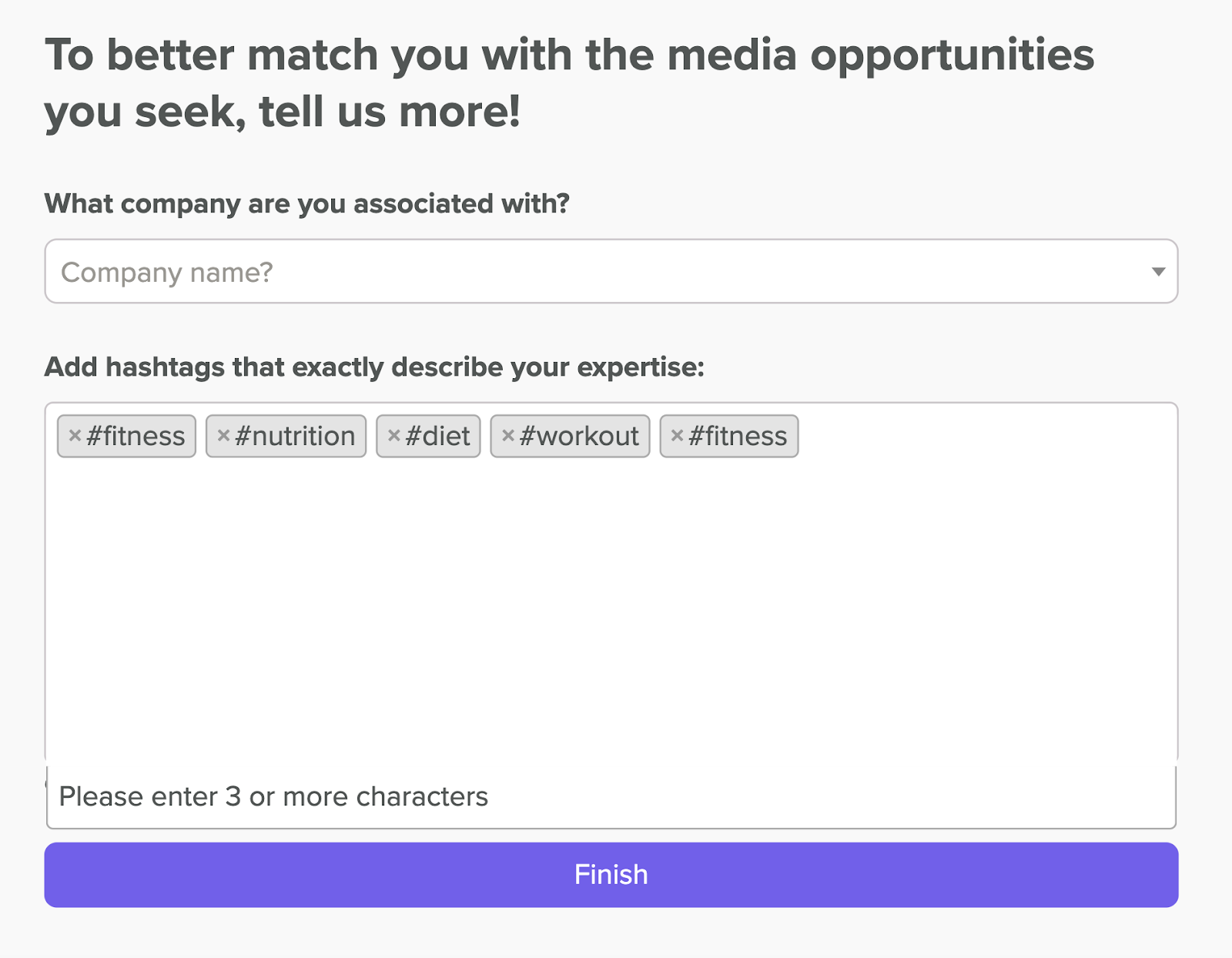
3. Respond to Journalist Requests with Unique Content
The final step is to respond to journalist requests with unique and valuable content.
This is where you need to stand out from the crowd and show your expertise.
Here are a few tips for a winning pitch:
- Be quick: Journalists often work on tight deadlines, so you need to respond as soon as possible
- Be relevant: Make sure your pitch matches the query and the journalist’s niche
- Be professional: Proofread your pitch for grammar, spelling, and punctuation errors
Digital PR
Digital PR is a link building tactic that involves creating and promoting high-quality content about your brand or niche to relevant journalists and publications.
The goal is to earn editorial links from authoritative and trustworthy sources that can boost your site’s rankings and visibility.
Digital PR content can include:
- Original, data-driven content promoted to journalists
- Press releases
- Newsjacking (writing about trending topics that are attracting a lot of attention)
Among other content types and approaches.
1. Come Up with Ideas
First, brainstorm ideas for your content that are newsworthy, interesting, and relevant to your niche.
You can use tools like Topic Research to find popular topics and questions in your industry.
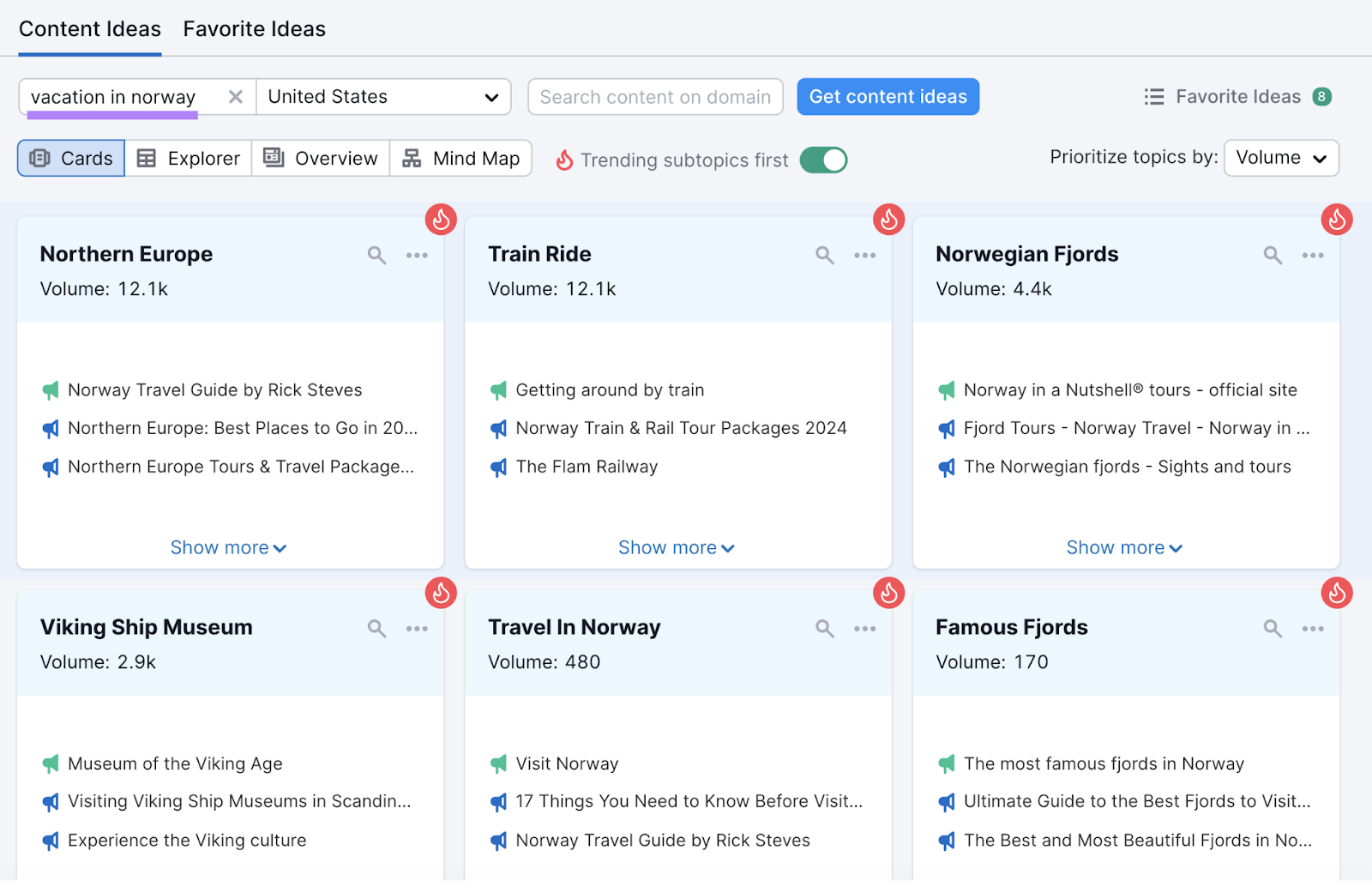
You can also look for internal data, surveys, reports, or case studies that you can use to create original and compelling stories.
2. Create Your Content
Then, create your content based on the idea you chose.
Make sure that your content is high quality, engaging, and informative.
Include a clear CTA and a link to a relevant page on your site.
Use catchy headlines, visuals, facts, statistics, and quotes to make your content more appealing and credible. And use a friendly and conversational tone that matches your brand voice and audience.
3. Build an Outreach List
The third step is to build a list of journalists, bloggers, and influencers who might be interested in covering your content.
You can use the Link Building Tool to find relevant prospects and their contact information.
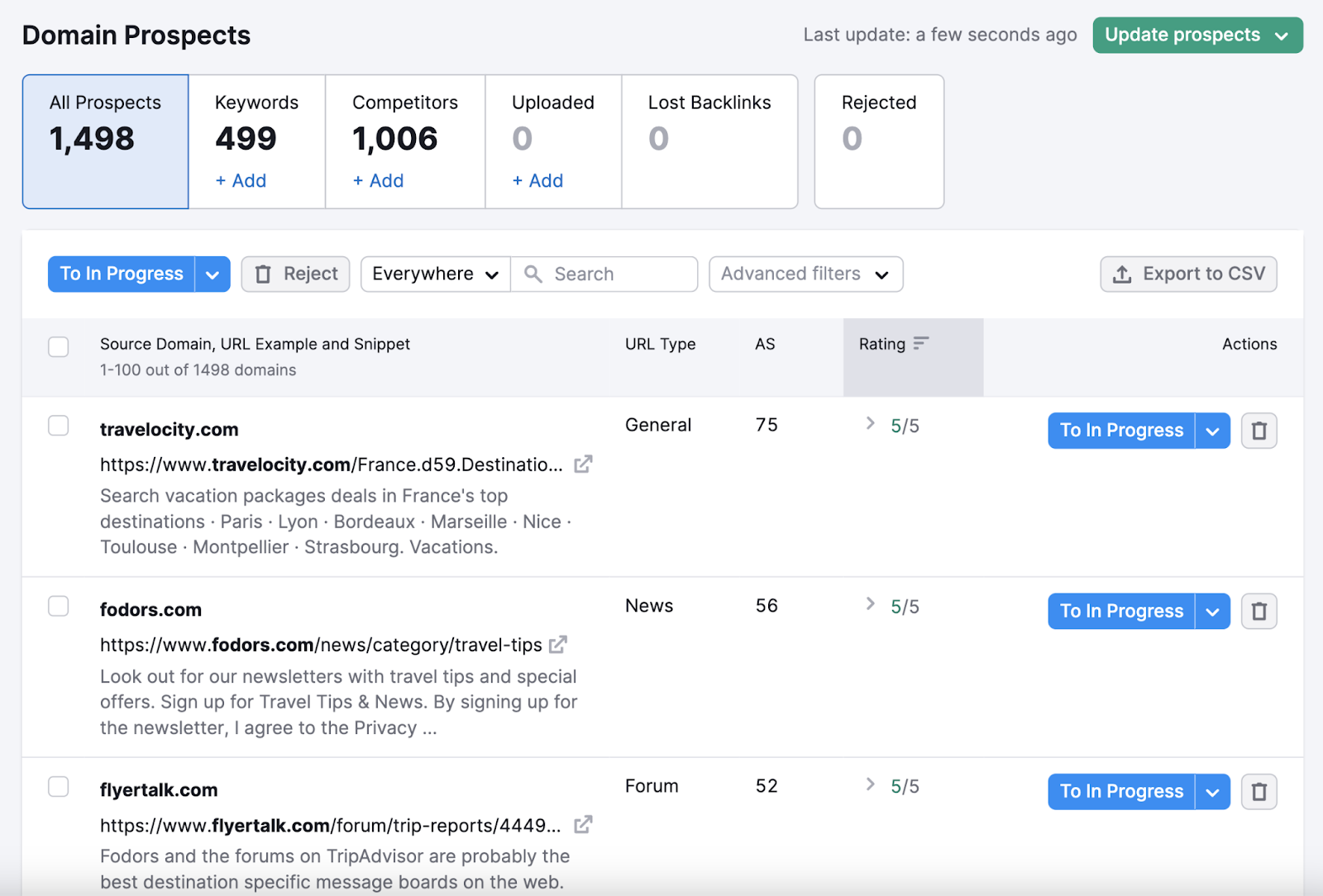
Or you can use social media, Google News, or online directories to find potential targets.
Whichever method you choose, select outreach prospects based on their site’s Authority Score, traffic, topic relevance, audience size, and linking history. To increase your chances of success.
4. Send Your Pitch
You now need to send your pitch to prospects and persuade them to feature your content and link to your site.
To do this, craft a personalized and compelling email that captures their attention and shows them the value of your content.
Some best practices to write an effective pitch include:
- Addressing prospects by their names and showing you know their work and audience
- Explaining why your content is relevant, timely, and useful for them and their readers
- Including a link to your content and a brief summary of the main points
- Asking them politely to link to your site or landing page if they decide to cover your content
Further reading: How to Write the Perfect Media Pitch in 5 Steps
6 Tips to Make Your Link Building Outreach More Successful
Here are six tips that’ll help you get more positive responses and more backlinks from your outreach campaigns.
Review Your Current Backlink Profile
A backlink audit analyzes the quality, quantity, and relevance of your site’s backlinks.
It can help you see how well you’re doing with link building, find what types of content drive the most backlinks, spot any weaknesses, and more.
Open Backlink Audit, enter your domain, and click “Start Backlink Audit.”

Once you configure the tool, it’ll audit your site and display a dashboard with your site’s Authority Score, referring domains, backlinks, and toxicity score.
Like this:

Review Your Competitors’ Backlink Profiles
The next tip is to review the competition’s backlink profiles.
This will help you see who’s linking to them, the content and topics that get the most backlinks, and how you can beat them.
You should also look for any common or unique link sources your competitors have. And see how you can leverage them for your own site.
You can run each competitor’s site through Backlink Analytics.
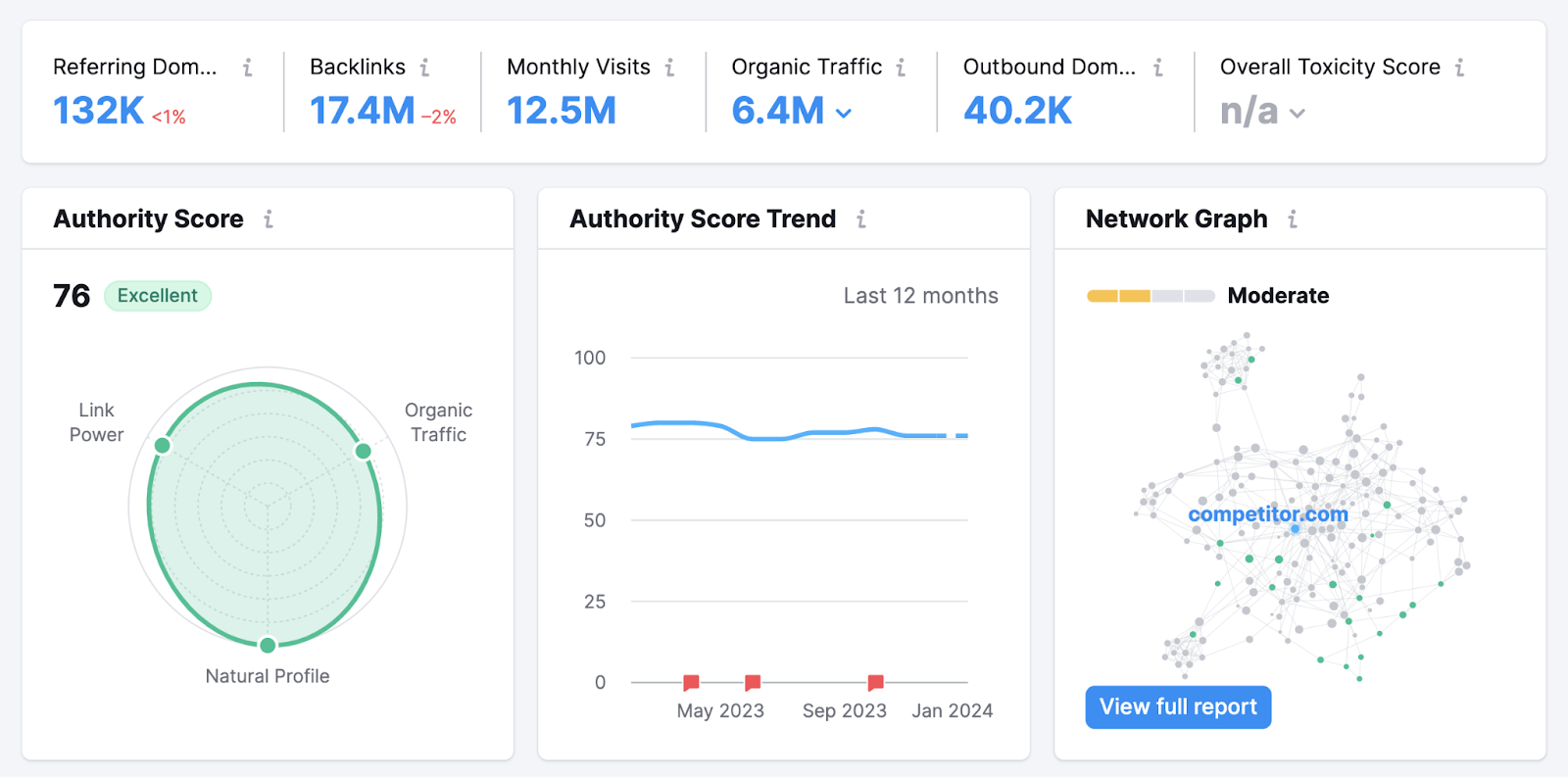
Or use the Bulk Analysis tool to compare up to 200 domains at once.
Like this:
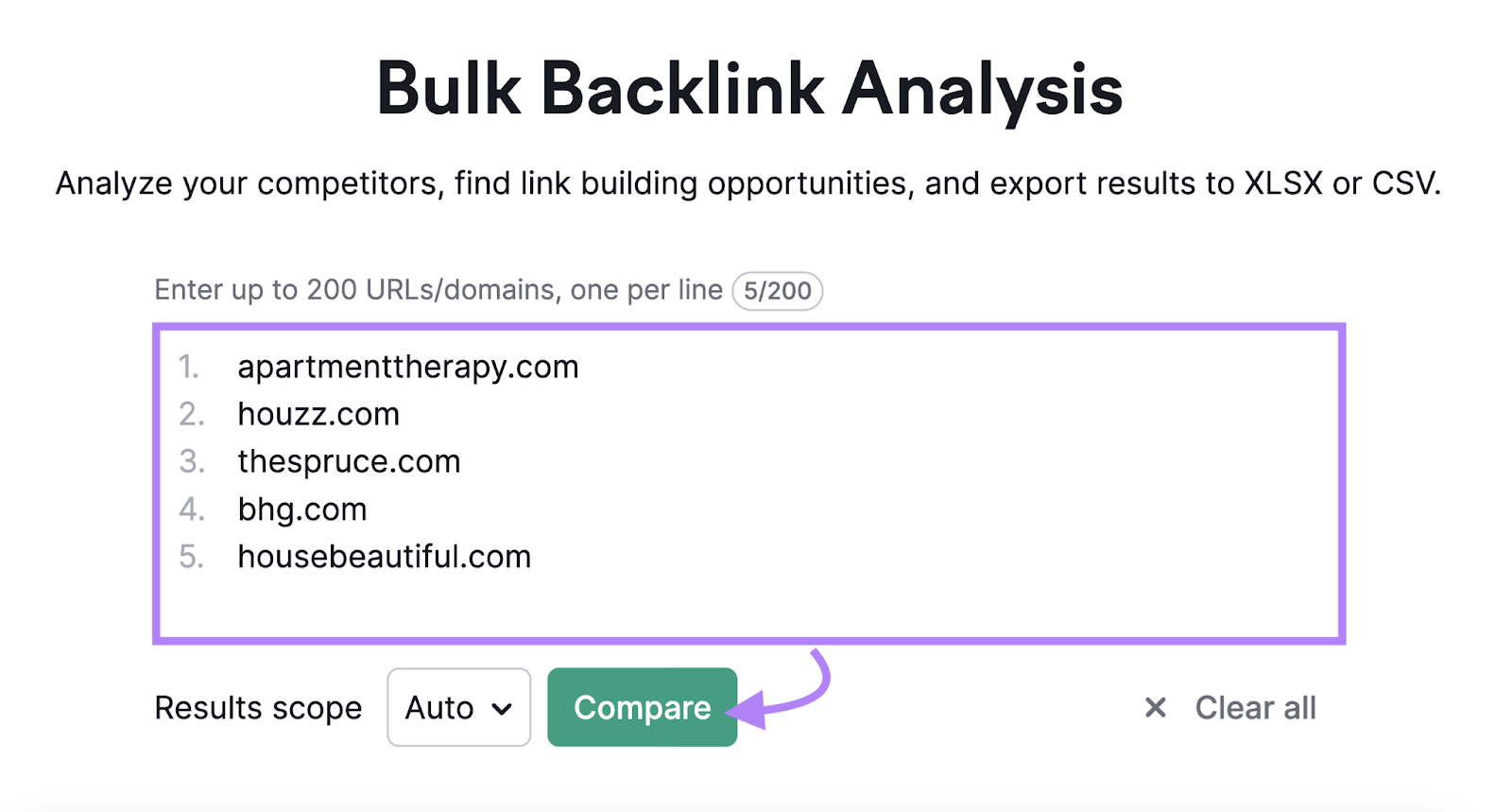
Understanding your competition will give you the best chance of success when you use any of the techniques listed above.
Prepare Outreach Emails with the Link Building Tool
The Link Building Tool helps you connect with the best prospects. And manage your outreach efforts from the prospecting stage all the way to outreach.
Once you’ve added the keywords and competitors and found a good prospect, you can move it to your outreach list by clicking “To In Progress.”
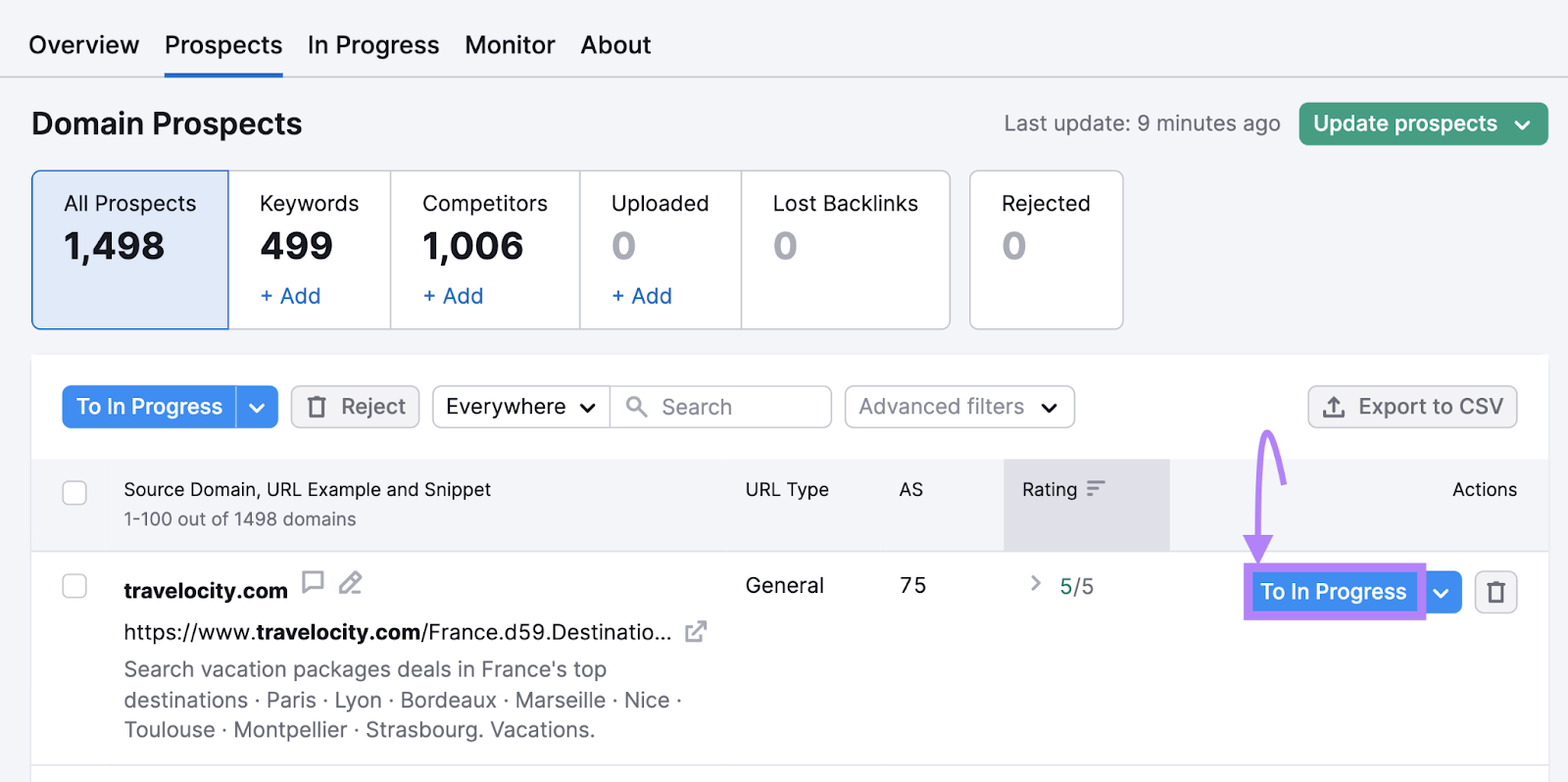
Do this for each prospect you want to contact. And then go to the “In Progress” tab.
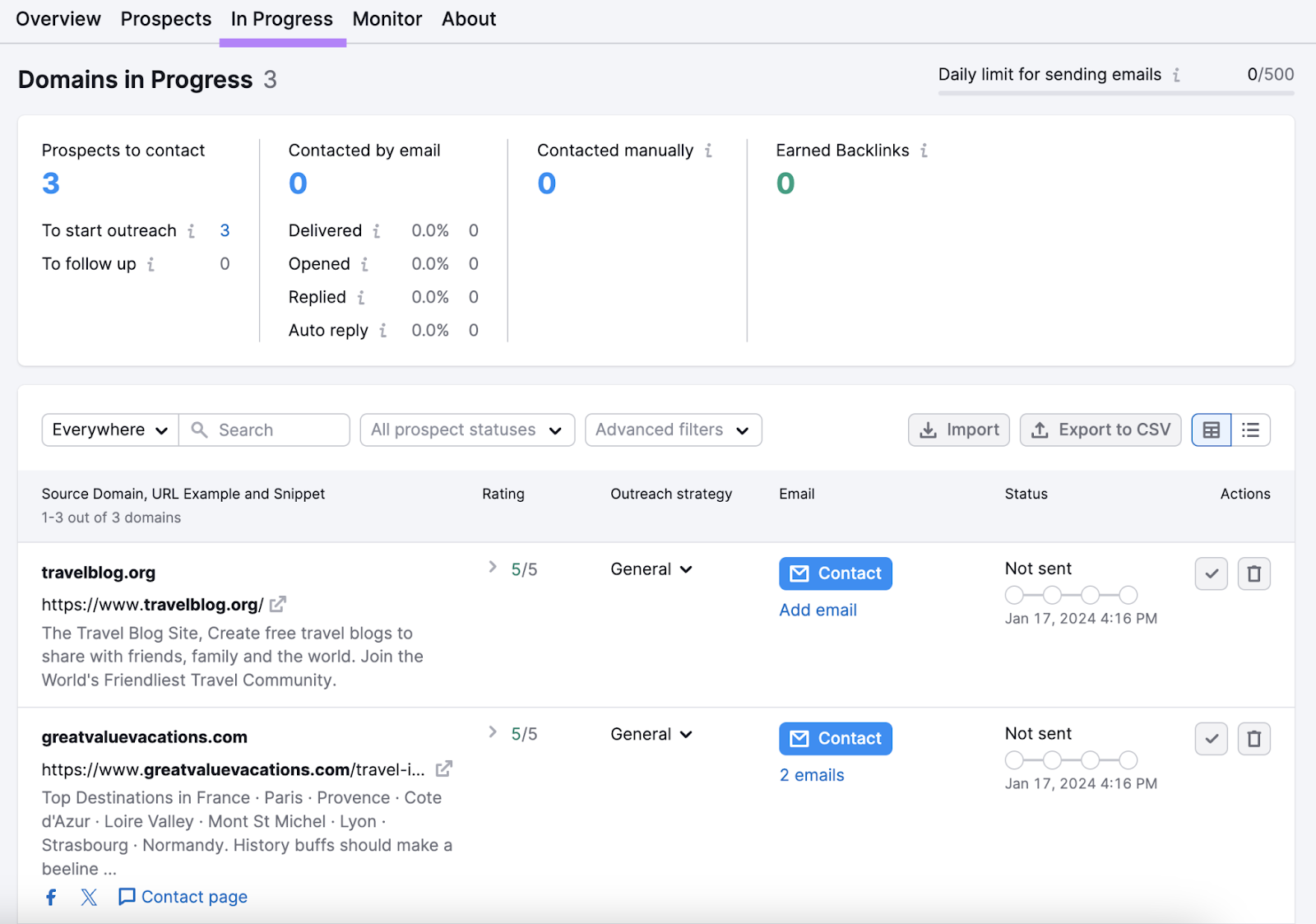
From here, you can use one of the outreach templates and email them directly. (You’ll need to connect your chosen email client to the tool first.)
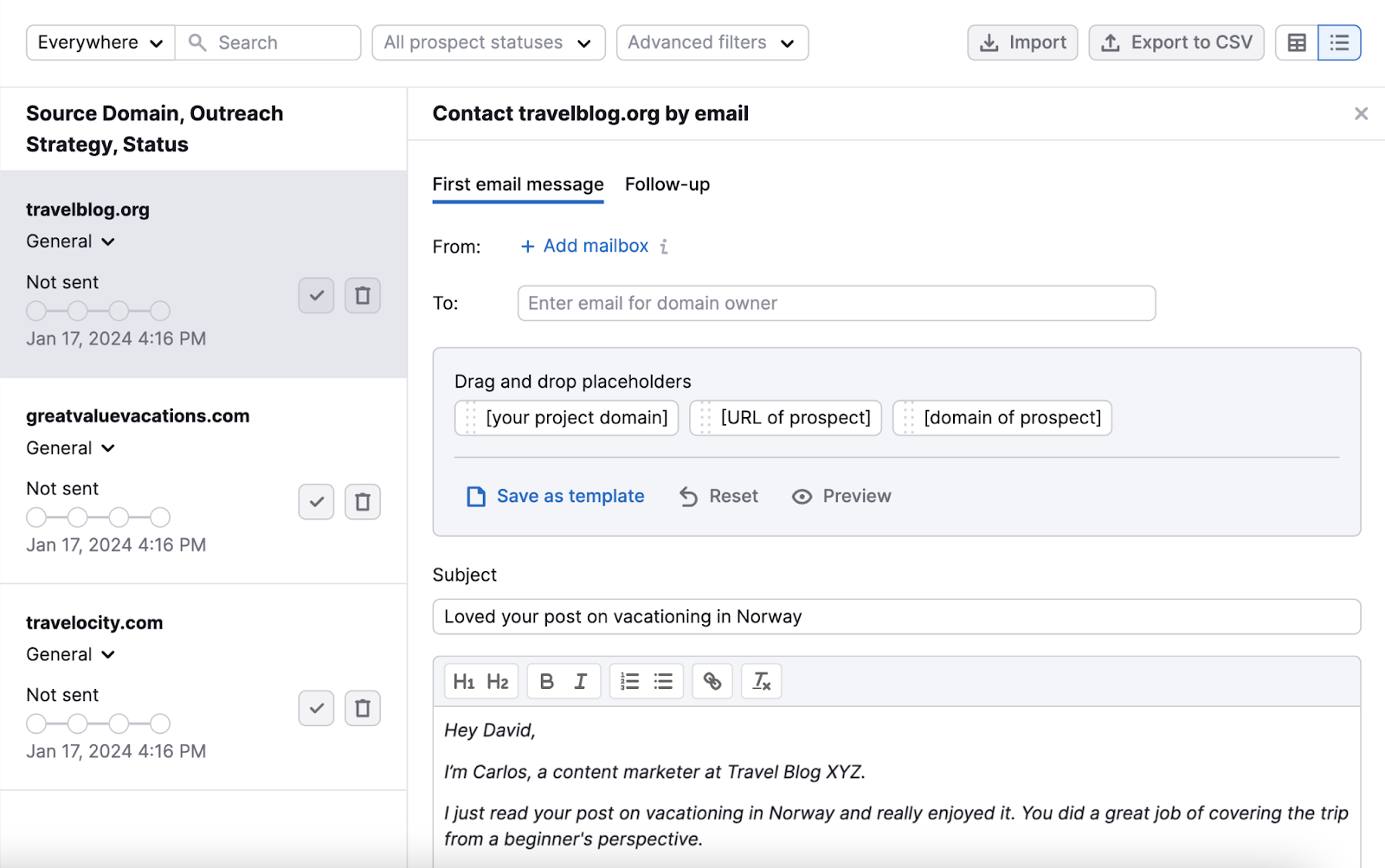
Conduct a Gap Analysis
Running a backlink gap analysis is a great way to see who’s linking to your competitors but not to you.
This is a wonderful tactic because if they’re happy linking to your competitors, they’ll likely be happy to link to you, too. Especially if your content is better.
Open the Backlink Gap tool. Then, enter your domain, enter your competitors’ domains, and click “Find prospects.”
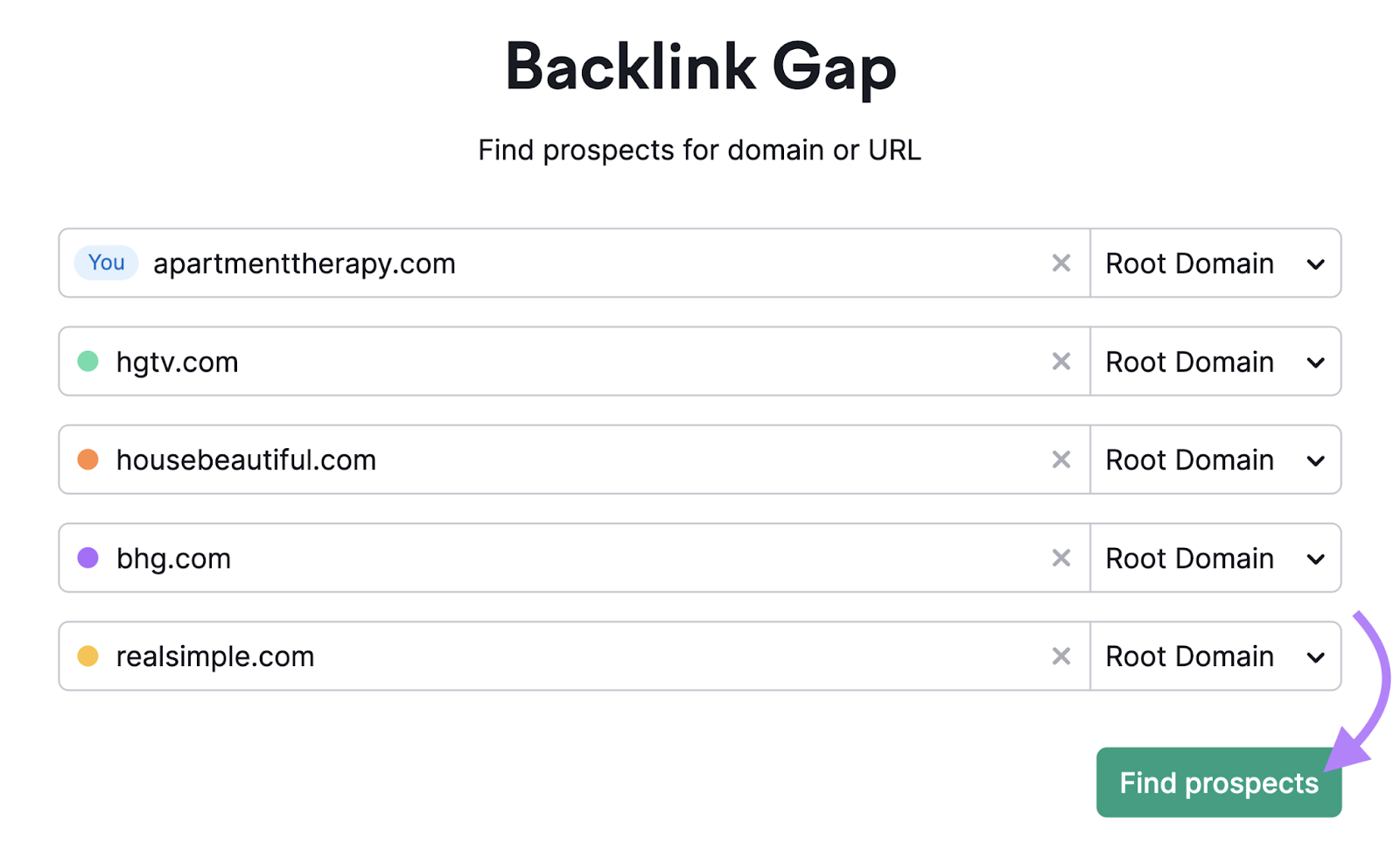
You’ll see a table with all the referring domains that link to your competitors but not to your site.
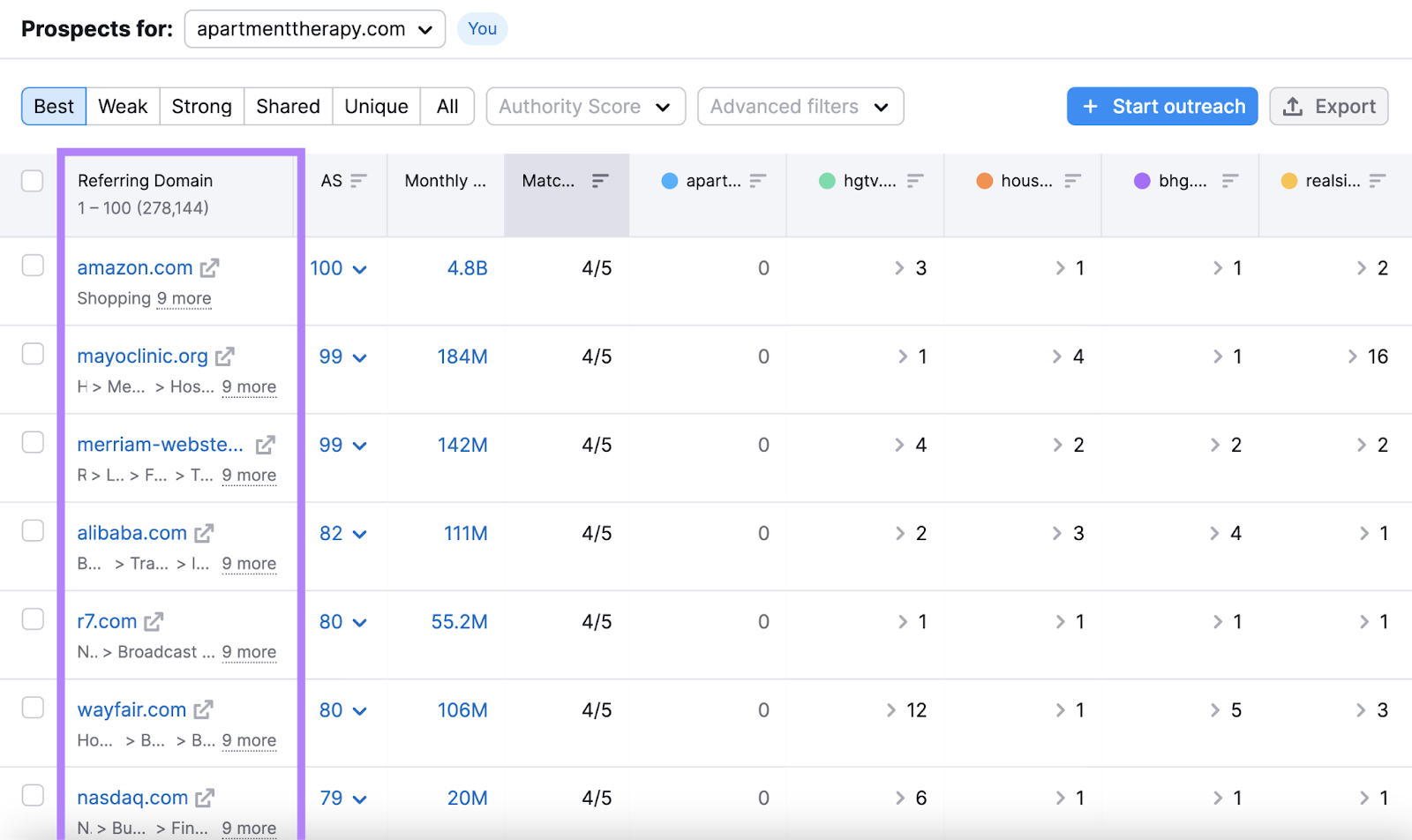
Now, you have a list of websites you can reach out to for backlinks.
Verify Email Addresses
One of the most common reasons why outreach link building fails is because the emails never reach the intended prospects.
This can happen due to various reasons, such as:
- The email address is invalid or incorrect
- The email address is no longer active or in use
- The email address isn’t checked or opened by the prospect
To avoid wasting your time and effort, verify your prospects’ email addresses before you contact them.
Tools like the Mentioned – Outreach Wizard app can help.
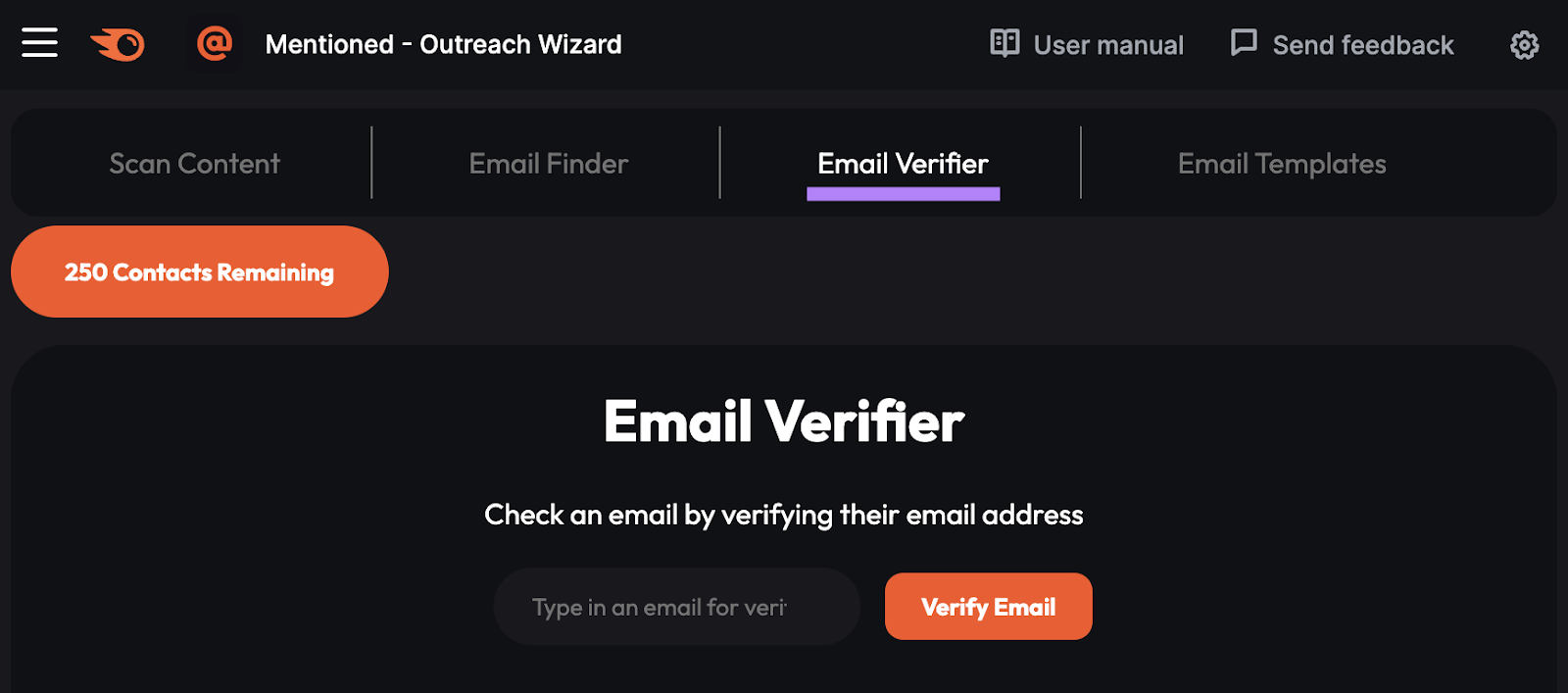
Personalize Your Outreach Emails
The last tip to make your link building outreach more successful is to personalize your outreach emails.
Personalization means tailoring your emails to your prospects’ specific needs, preferences, and interests.
It also means showing your prospects that you care about them and their goals. And that you aren’t just another spammer or bot.
Here are a few best practices:
- Introduce yourself and your site or organization
- Demonstrate a pain point (and how you’ll fix it)
- Keep it clear and concise
- Send your emails from a branded email address
Implementing these tips can keep your email from getting sent to the spam folder or trash bin.
Start Your Link Building Outreach Campaign Today
Ready to start your first backlink outreach campaign?
The link building methods and tips mentioned above are great places to start.
Use the Link Building Tool to set up your first campaign. Because it can help you:
- Quickly find prospects based on target keywords and competitors
- Organize a workflow to manage the outreach process
- Automatically find contact information for target websites
- Monitor your campaign’s progress over time
And more.
Source link : Semrush.com
